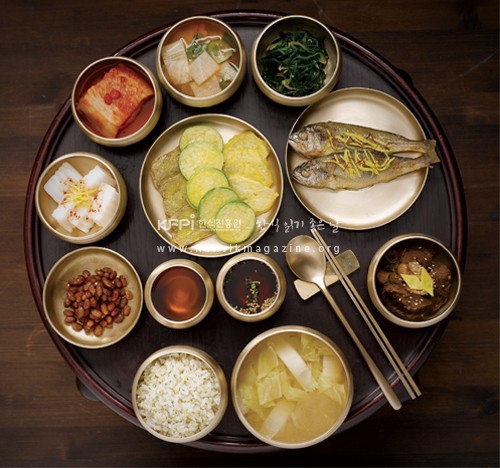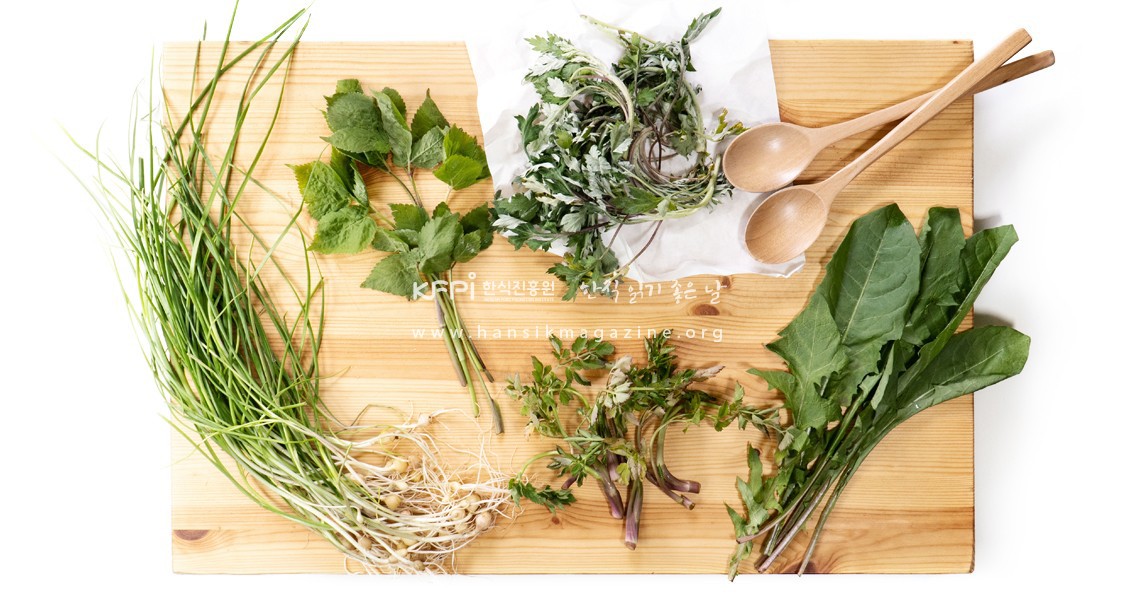한식 읽기 좋은 날
Vol 26. Namul - Gyeonggi Provi
Listen to the experts
Korean table with seasons and life
Korean table with seasons and life
Written by Kwon, Dae-young
Director of Agriculture and Fisheries Department, The Korea Academy of Science and Technology
Reviewing the development history of Korean food, it is not a matter of 'what to eat' culture, but a 'with what to eat (what to eat with?)' culture. When Korean set up a table, we always thought about who received the table and enjoyed serving them. It is such a thoughtful mind that Korean think about another person's favorite food and a healthy table. While respecting the person who received the table, we considered the option of the person who received the table to the end. For this reason, Korean food is not a dish culture like the West, but a table culture. Etiquette and philosophy are embedded in this table culture.
Korean food with respect and consideration

In the table culture, our mothers and grandmothers have always thought of a lot of harmony and balance with rice, soup, and side dishes. Today, this part has developed into a philosophy of the nutritional balance of Korean food and the harmony of human health. If you order food from a restaurant in another country, the options disappear after that. However, the Korean food culture is a so-called chopstick culture, where the choice is guaranteed right before entering the mouth. That's why our mothers sublimated Korean food into a serving culture. If four of you go to a Western restaurant, you will get four menus, but if four of you go to a Korean restaurant, only one menu is good enough.
With this table culture, Koreans from our ancestors have traditionally prepared a variety of tables depending on who they are, when to eat, and in what season. The table for the adults in the house, the table for the guests when they came, and the table for the people at work were different. Even the ritual for rain or the prayer for a good harvest and the characteristics of feasts made the tables different. A festival day such as the birth of a person, a birthday, or a wedding, or a day for mourning(funeral), sacrifice, or a seasonal prayer made the tales different as each dish was granted with different implements. Seasonal tables for new year's day or mid-January day, Choosuk, Dano, Chilsuk, Donggi etc are also different. Different foods were made to eat in seasons of spring, summer, fall, and winter. (see Kwon, Dae-young, Hansik culture, 2019). Our ancestors regarded it as the healthiest and entertaining virtue to serve the table using seasonal ingredients.
Korean food considering balance and harmony, health and diversity
The daily meal table of Koreans who eat every day was the table prepared with the basic structure and characteristics of Korean food, based on namul(wild greens) that can be obtained in the garden side, depending on the season.
On the basis of rice and soup or stew, and kimchi as well as using vegetable obtainable from the season, our mothers have prepared the tables for the family every day. They have composed of side dishes with numerous recipes to suit the taste of the family, weather, and ingredients. From an agronomic point of view, the table culture of Korea cannot be accurately specified but seems to have been established before the Goryeo Dynasty, when rice and soup appeared. At that time, it was bricolage foods prepared on the spot, focused on the ingredients that could be obtained from the garden, however, with long term experiences and loves and devotions to the family, nutritionally balanced tables were set even today. Which seasoning to be chosen to set the taste out of soy sauce, soybean paste, and red chili paste has been decided by mother according to the season or the type of greens and family preferences. And the side dishes were made mainly with greens seasoned with garlic, green onion, ginger, hot pepper powder, sesame oil or perilla oil.
The tables of our country are also very well balanced from the nutritional aspect. At this point, they are naturally comprised to suit the golden ratio of vegetable and animal foods by including one or more side dishes using meat, fish, eggs, and bean curd that could provide protein. It is a very healthy table that contains balanced nutrients and phytochemicals that can prevent metabolic diseases and provides all prepared foods at once. It also has the advantages that we can choose foods that suit us according to our nutrient needs, preferences, and health status.
For example, in the spring, the table is prepared with spring greens such as fragrant wild chives, fatsia, chives, groundsels, etc which are obtainable in the mountains and fields to ingest vitamins and minerals that were scarce in winter. As for vegetables, having only eaten kimjang kimchi and stored vegetables, the spring greens bring the fresh mood of spring to help the body wake up when spring comes. In addition, vitamins B1, B2, and vitamin C were supplemented to help metabolize energy and revitalize the body so that they could overcome spring pain. Spring greens, which are obtained everywhere in the mountains and fields, were used as ingredients for soup or stew, or they were seasoned with raw vegetables and boiled to make simmered vegetables. Some of the broad leaves were eaten as ssam(leaf wrap). Any leafy vegetables of the season, such as lettuce, gomchwi, crown daisy, water parsley leaf, and sesame leaf etc, could be used as ssam materials and served with various foods including red chili and soybean paste. Ssam is not the food eaten with a person who has met for the first time or needs to be formal, but it is a friendly and healthy food suitable for a comfortable atmosphere and daily life.

Korean table culture developed in an environment with rivers and rice fields
The development history of not only Korean food but also food in countries around the world have the same direction. There is always a historical and natural background behind it.
That is, scientifically speaking, the food development of countries in the world is 'how can I eat?' is a priority, and then 'how can I eat deliciously?', and 'how can I eat it later?', it has developed to these directions from tens of thousands of years ago. As the Korean people, based on the Korean Peninsula and Manchuria, have been seated in the direction naturally blessed with rivers and rice fields, we have had plenty of grains and greens to eat. So, we haven't had to be nomadic. However, these rice, barley beans, grass must be eaten somehow to survive, we were forced to boil and cook rice, boil the grass, or make greens in raw to eat. How to eat grains safely? was mainly solved by using fire. And, it was a seasoned culture developed by thinking about how to eat grasses deliciously.
It is the birth of fermented food of kimchi and soybean that have been developed tens of thousands of years ago after the Korean people pondered, 'How can I eat it later?'
The red is the best food color that looks delicious when the red color involved, and it gets more delicious when the spice gets in and the spice or sour taste enters. That is why red pepper powder was used a lot, and seasonings such as garlic were used. Because of this seasoning culture, the taste of Korean food is called 'fingertip taste'. These seasoned foods were left to eat but had no problems at all even if we ate them later. This is the birth of kimchi. The same goes for the creation of red chili paste, soybean paste, soy sauce. It is the indigenous fermentation culture in Korea that solved the above three problems at once. Fermentation culture in our country is the one in which our ancestors' traditional knowledge and life have been infused. Eating greens in season deliciously and fermenting them later as well, is our traditional fermentation technology, which is the key point of our meal table culture having care, balance, and health combined together.
There are some people who are not familiar with the geopolitical and historical characteristics of food often lament that Korea is a country that is not rich in food, saying that Korea has had less chance to eat meat(protein) and milk, for example, that the animal husbandry industry is not well developed. It is like talking about our people as an unblessed people.
However, in fact, people living in Mongolian land cannot survive because of the ridiculous lack of nutrients from grassroots grown there. This is because humans cannot digest cellulose. The Mongolian people have solved the problems caused by unblessed land and climate by farming sheep. How amazing it is? Their land cannot be lived without sheep. It is not to be envious of. Eating less seasonal vegetables, such as phytochemicals, their life expectancy is not very long.
On the other hand, China did not need to create various greens or fermentation cultures. Because they had blessed wide plains, magnificent rivers, and the sea, all agricultural and marine products are abundant, and pork oil or fish oil is rich. So, if they fry and cook all the food ingredients, it will be safe to eat and tasty as they are cooked at high temperatures. Frying food dehumidifies so that eating them later doesn't cause stomach diseases. Therefore, Chinese food is called as the flame taste. However, today's Chinese food is cooked at a high temperature, such as frying, so there are many oxides such as free radicals that generate health problems steadily.
In the future, Korean food will be the best food in the world thanks to its balance and harmony, respect and consideration, health and diversity, as well as tradition and culture.
Dae-Kwon Kwon
served as Director of Agricultural Science and Fisheries, The Korea Academy of Science and Technology, also served as Senior Research Director (Deputy Director), and Director of the Korea Food Research Institute. He is the author of the Korean Food and Humanities, the truth of the pepper tradition, the path of sustainable growth in the food industry, and Korea Function Foods. He is now working as the chief editor of Journal of Ethnic Foods.

 한국어
한국어
 English
English






